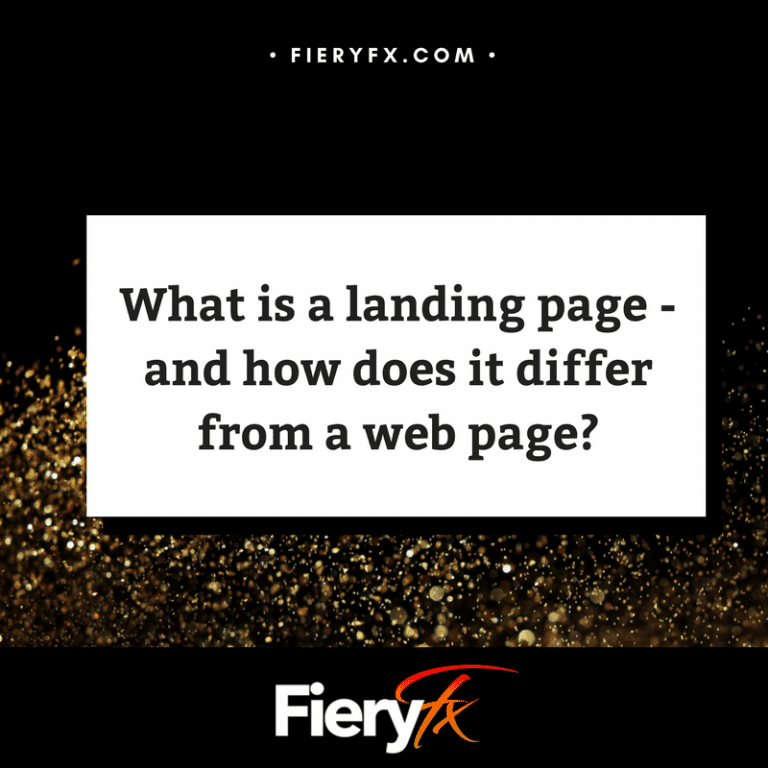What is a landing page – and how does it differ from a web page?

There’s a lot of confusion out there about the differences between web pages and a landing page. I see it frequently when talking to my clients. After all, what is a landing page? Is it just something that you “land” on after you click on a link?
Well, a landing page (a good landing page anyway!) is a lot more involved than just a link destination. It’s got 3 core differences when compared to a regular web page, and it’s hugely important that you know these differences (or that your marketing team does!).
What is a landing page vs a web page: key difference #1: the purpose
A web page: The first core difference between a landing page and a web page is its intended purpose. Generally speaking, a web page is any page on your website. It could have any of a dozen purposes or a dozen purposes on one page. Think of your favorite website. Now, think of what its purpose is. If you can’t immediately identify its purpose, it’s probably a regular web page and not a landing page.
A landing page, also known as squeeze pages or sales pages, has exactly one purpose. One: no more, no less. Think of a website that advertises some sort of a webinar, white paper or PDF report to download, or a sign up for a news letter. Would you want to advertise all three of those things on one page? No, of course not! Visitors would get too distracted by all of the options (and more on this in a moment).
That’s why a landing page has one purpose. One landing page would promote a webinar. Another to make a pitch for a single product. Or a third to promote a PDF download as a sales pitch to get that visitor to sign up for your email list. One purpose. One per landing page.
What is a landing page vs a web page: key difference #2: the format
Remember how I mentioned that having too many purposes on one page can get confusing? Well, think about that favorite website of yours again. It’s typically got the same header and footer as the rest of the website. It looks and fits with all of the other pages. And we can use the menus to navigate around anywhere we want on that website, right? Yup.
Well, with all of the sidebars, newsletter sign up widgets, and whatever else, you’re encouraging people to navigate around your site (they might even navigate away from your site). A web page floods you, the visitor, with options.
That landing page’s format, on the other hand, only gives you two options: say yes to whatever is being promoted OR close the browser.
There’s no navigation menu or header to match the website. It’s stripped of anything that would encourage the viewer to go anywhere else. There might be a footer with a link back to terms of services, but other than that, outbound links are probably nonexistent. In other words, the format of a landing page supports that single purpose we mentioned earlier: keep people reading and on the page so that they’ll sign up for or buy what’s being promoted.
What is a landing page vs a web page: key difference #3: the placement
Web pages are vital to your business. You need your online storefront there so it can be seen, after all! But it’s important to remember that placement in your sales funnel is key. And we want to use that placement to help guide visitors towards your marketing funnel.
So here’s a quick, dirty, and simplified rundown on the placement: you (and your marketing department) will be using social media to guide visitors to your website. Your website may direct people to learn more at your blog. Then, your blog and your email list may direct readers to a single, special deal being offered on a specific landing page. From there, they’ll have the choice to say either “no” or “YES!” to the offer.
Quick, dirty, and simplified, but you’ve got the vision now.
Now, a quick side note away from the “what is a landing page” topic. You can always use various analytics to see where people are in the conversion process. That way, you can determine how effective a marketing process is – and make it even better. But using testing and tools (like heat mapping, hot jar, and more) is an involved topic for another post.
And since we did simplify things, here’s a quick pro tip… If you want to really go for the marketing gold, remember to offer a “next step” after the visitor has taken the recommended action on your offer. Maybe that next step is as simple as connecting with you on social media or sending you a tweet. In fact, that’s a great way to get some extra marketing mileage out of your “thank you” page.
Using these 3 key differences between web pages and landing pages, you’ll no longer be wondering “what is a landing page?” You’ll be light years ahead – perfecting your landing pages. And you’ll do that by focusing them on one thing, formatting them to focus on that one purpose, and keeping it perfectly placed in your sales funnel.
If you want to talk more about landing pages, marketing funnels, or digital marketing, then let’s chat.
Are you a visual learner? That’s cool. Just click here to watch instead.

